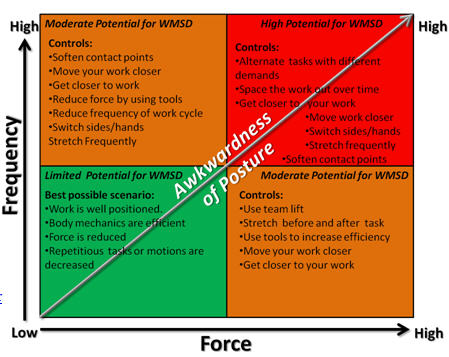Improving Housekeeping Ergonomics, Part II - Risk Relationships
The last housekeeping blog identified force, frequency, and posture as key risk factors that play important roles in increasing or decreasing the potential for work-related musculoskeletal disorders (WMSDs).
To prevent WMSD’s it is important to understand the critical relationship between these risk factors. With any task or behavior, the potential for injury gets higher as frequency and force increase. Taken separately, or even together, these to risk factors can be managed in the following ways:
- Reduce the force required by limiting weight of items and by using mechanical aids to reduce lifting and reaching.
- Reduce frequency by taking micro breaks, rotating tasks, or switching hands.
The wild card in the equation is posture. According to freedictionary.com, good posture “is usually considered to be the natural and comfortable bearing of the body in normal, healthy persons... good standing and sitting posture helps promote normal functioning of the body's organs and increases the efficiency of the muscles, thereby minimizing fatigue.”
Awkward postures decrease muscle efficiency, increasing the energy it takes to do a task, therefore increasing the potential for injury. Some examples in housekeeping are:

The relationship between the 3 factors can be shown graphically:

The greater the force and frequency of the task and the awkwardness of the posture necessary, the likelihood of WMSD’s increase.
Housekeeping tasks can be grouped by their frequency, force, and posture. These groups can be used as a guide to rotate work, distribute tools, and make work assignments.
A full page graphic for printing can be found at MEMIC Safety Director under Ergo Tools.
The final installment of the housekeeping ergo blog will provide a tool for risk evaluation. Stay tuned.
Improving Housekeeping Ergonomics, Part I
Improving Housekeeping Ergonomics, Part III - Check Your EARSS

